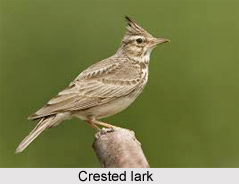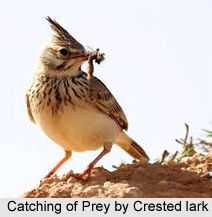 Crested Lark is an Indian bird that bears scientific name of "Galerida cristata" and is a species of lark distinguished from the other 81 species of lark by the crest of feathers that rise up in territorial or courtship displays and when singing.
Crested Lark is an Indian bird that bears scientific name of "Galerida cristata" and is a species of lark distinguished from the other 81 species of lark by the crest of feathers that rise up in territorial or courtship displays and when singing.
Concentration of Crested Lark
Crested Lark is common to mainland Europe, the birds can also be found in northern Africa and in parts of western Asia and China.
Nature of Crested Lark
Crested Lark is a non-migratory bird, but can occasionally be found as a vagrant in Great Britain
Description of Crested Lark
Crested Lark was one of the many species originally described by Linnaeus in his 18th-century work, Systema Naturae. He gave it the binomial name Alauda cristata. German naturalist Friedrich Boie placed it in the new genus Galerida in 1821, but did not define what characters distinguished from larks in the genus Alauda. Colin Harrison recommended sinking members of Galerida and Lullula back into Alauda in 1865 due to lack of defining characters.
Structure of Crested Lark
Crested Lark is fairly small lark and is roughly the same size as a Eurasian skylark, but shorter overall and bulkier around the head and body, and very similar in appearance, with a height of 17 cm (6.7 in) and a wingspan of 29 to 38 cm, weighing between 37 and 55 g (1.3 and 1.9 oz). It is a small, brown bird which has a short tail with light brown outer feathers. Males and females have no real differences, but young crested larks have more spots on their back than their older counterparts.
 Plumage of Crested Lark
Plumage of Crested Lark
The plumage of Crested Lark is downy but sparse and appears whitish. The distinct crest from which the crested lark gets its name is conspicuous at all times but is more pronounced during territorial or courtship displays and when singing.
Flight of Crested Lark
In flight, Crested Lark shows reddish under wings. It shares many characteristics with the Thekla lark, with the main distinctions between the two being the Thekla`s heavier black-brown streaks and its grey under wing, present in European specimens.
Breeding Season of Crested Lark
Crested lark breeds across most of temperate Eurasia from Portugal to north-east China and eastern India, and in Africa south to Niger. It is non-migratory, and the sedentary nature of this species is illustrated by the fact that it is only a very rare vagrant to Great Britain, despite breeding as close as northern France.
Behaviour of Crested Lark
Crested Lark is a common bird of dry, open country and is often seen by roadsides or in cereal fields, although it is also found occupying small, sandy patches by railways, docks and airfields.
Call of Crested Lark
Crested Lark is a songbird, and has a liquid, warbling song described onomatopoeically as a whee-whee-wheeoo or a twee-tee-too. It sings in flight from high in the sky, at roughly 30 to 60 m (98 to 197 ft) above the ground. The related skylark exhibits similar behaviour but also sings during its ascent, whereas the crested lark sings either at altitude or on the ground. Their flight pattern is an example of adulatory locomotion.
Nests of Crested Lark
Crested Lark nests in small depressions in the ground, often the nests of Crested Lark are found in wastelands and on the outskirts of towns. The nests are untidy structures composed primarily of dead grasses and roots.



















